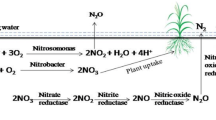Abstract
To estimate the greenhouse gas emissions from paddy fields of Cambodia, the methodology of the Intergovernmental Panel on Climate Change (IPCC) guidelines, IPCC coefficients, and emission factors from the experiment in Thailand and another country were used. Total area under rice cultivation during the years 2005–2006 was 2,048,360 ha in the first crop season and 298,529 ha in the second crop season. The emission of methane from stubble incorporation with manure plus fertilizer application areas in the first crop season was estimated to be 192,783.74 ton higher than stubble with manure, stubble with fertilizer, and stubble without fertilizer areas. The fields with stubble burning emitted the highest emission of methane (75,771.29 ton) followed by stubble burning with manure (22,251.08 ton), stubble burning with fertilizer (13,213.27 ton), and stubble burning with fertilizer application areas (3,222.22 ton). The total emission of methane from rice field in Cambodia for the years 2005–2006 was approximately 342,649.26 ton (342.65 Gg) in the first crop season and 36,838.88 ton (36.84 Gg) in the second crop season. During the first crop season in the years 2005–2006, Battambang province emitted the highest amount of CH4 (38,764.48 ton) and, in the second crop season during the years 2005–2006, the highest emission (8,262.34 ton) was found in Takeo province (8,262.34 ton). Nitrous oxide emission was between 2.70 and 1,047.92 ton in the first crop season and it ranged from 0 to 244.90 ton in the second crop season. Total nitrous oxide emission from paddy rice field was estimated to be 9,026.28 ton in the first crop season and 1,091.93 ton in the second crop season. Larger area under cultivation is responsible for higher emission of methane and nitrous oxide. Total emission of nitrous oxide by using IPCC default emission coefficient was approximately 2,328.85 ton. The total global warming potential of Cambodian paddy rice soil is 11,723,217.03 ton (11,723 Gg) equivalents of CO2.
Similar content being viewed by others
References
Bandyopadhyay, S. K., et al. (2001). Estimation and agro-technical description of production systems. In Land use analysis and planning for sustainable food security: With an illustration for the state of Haryana, India. ICAR, New Delhi and IRRI, Philippines, 85.
Bhatia, A., Pathak, H., Jain, N., Singh, P. K., & Singh, A. K. (2005). Global warming potential of manure amended soils under rice-wheat system in the Indo-Gangelic plains. Atmospheric Environment, 39(37), 6976–6984.
Davidson, E. A., Swank, W. T., & Perry, T. O. (1986). Distinguishing between nitrification and denitrification as source of gaseous nitrogen production in soil. Applied and Environmental Microbiology, 52, 1280–1286.
Food and Agriculture Organization (2006). Report on plant breeding and biotechnology capacity survey Thailand. http://apps3.fao.org/wiews/docs/Thailand%20Full%20Report.pdf.
Intergovernmental Panel on Climate Change (IPCC) (1996). Good practice guidance and uncertainty management in national greenhouse gas inventories. Cambridge: Cambridge Univ. Press.
Intergovernmental Panel on Climate Change (2001a). Climatic change 2001: Synthesis report, summary for policymakers. Wembley: IPCC.
Intergovernmental Panel on Climate Change (IPCC) (2001b). Good practice guidance and uncertainty management in national greenhouse gas inventories. Montreal: IPCC.
MAFF (Ministry of Agriculture, Forestry, and Fisheries) (2005). Planing and statistics 2004–2005. Phnom Penh: MAFF.
Organization for Economic Cooperation and Development (2001). Environmental indicators for agriculture: Methods and results. Paris: OECD.
Watanabe, A., Yamada, H., & Kimura, M. (2005). Analysis of temperature effects on seasonal and interannual variation in CH4 emission from rice-planted pots. Agriculture Ecosystems & Environment, 105, 439–443. doi:10.1016/j.agee.2004.02.009.
Yu, K. W., Wang, Z. P., Vermoesen, A., Patrick, W. H., Jr., & Van Cleemput, O. (2001). Nitrous oxide and methane emissions from different soil suspensions: Effect of soil redox status. Biology and Fertility of Soils, 34, 25–30. doi:10.1007/s003740100350.
Author information
Authors and Affiliations
Corresponding author
Rights and permissions
About this article
Cite this article
Vibol, S., Towprayoon, S. Estimation of methane and nitrous oxide emissions from rice field with rice straw management in Cambodia. Environ Monit Assess 161, 301–313 (2010). https://doi.org/10.1007/s10661-009-0747-6
Received:
Accepted:
Published:
Issue Date:
DOI: https://doi.org/10.1007/s10661-009-0747-6




